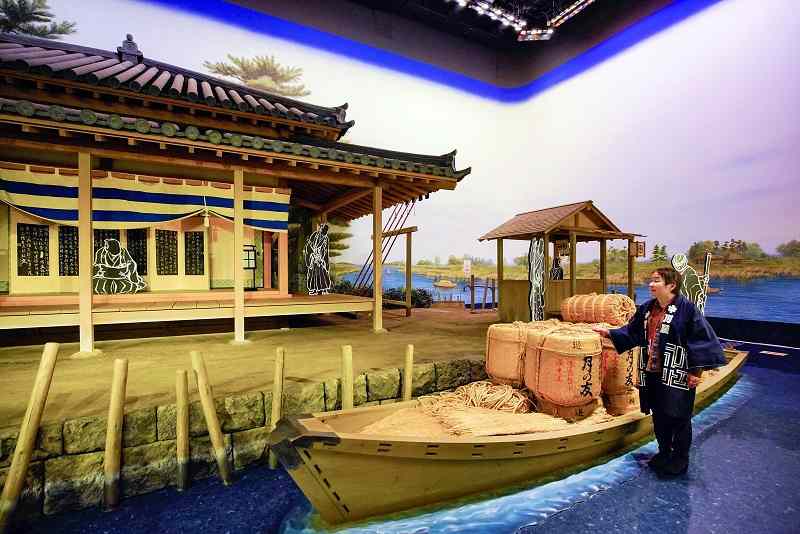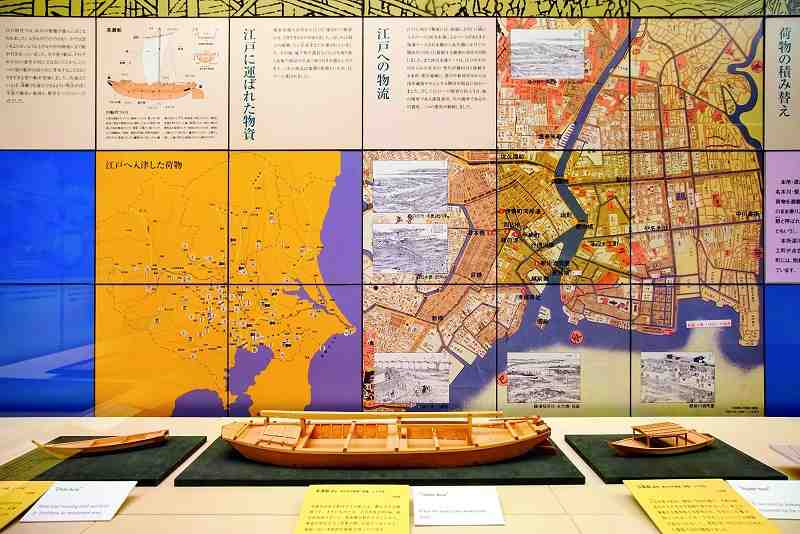
A diorama depicting a scene at the Nakagawa Bansho during the Edo period. The blue-colored floor gives an impression of the river’s surface.
16:41 JST, May 25, 2021
The Nakagawa Bansho inspection facility played a vital role keeping track of ships coming and going in the network of waterways that underpinned the transportation of consumer goods in the de facto capital during the Edo period (1603-1867).
While the facility is long gone, the Nakagawa Funabansho Museum is located near the checkpoint’s original location at a well-positioned juncture where the Onagi River flows into the Kyunaka River in what is now Koto Ward, Tokyo. Visitors to the museum can learn about the history of inspection control and water transportation during the Edo period and beyond.
Waterways for the distribution of goods were developed shortly after warlord Tokugawa Ieyasu moved to the Kanto region in the late 16th century. The Onagi River was dug on his orders primarily for transporting salt from Gyotoku, in present-day Ichikawa, Chiba Prefecture. In 1661, the Nakagawa Bansho was established and for more than 200 years the inspection facility monitored the flow of barges and ships that traveled between Edo and other parts of the Kanto region as well as what is now the Tohoku region.

A replica of a travel pass needed to go through the Nakagawa Bansho checkpoint.
Rice and sake were some of the mainstays entering Edo on boats, and workers at the inspection facility checked travel passes, goods and their quantities, which helped to contribute to the Tokugawa shogunate’s price control policy. The Nakagawa Bansho was also used to enforce crackdowns on guns coming into the city and women leaving the city. Visitors to the museum can also take a look at a replica of a travel pass.
But the museum’s centerpiece is a full-scale replica of the Nakagawa Bansho replete with a shogunate official inspecting a moored barge laden with bags of rice and barrels of sake from areas outside Edo. Over a sound system, visitors can hear a voice asking the bargeman, “Do you have a travel pass?!” Furthermore, the lights in the room mimic the passing of time from morning to evening.
The replicated scene is based on findings from an excavation survey conducted in 1995 as well as drawings from the Edo period.
Water transportation after the 1868 Meiji Restoration is also featured at the museum. By that time, the Nakagawa Bansho was no longer used as an inspection facility. But its location on the Onagi River, which had a direct link to the capital, gained importance as modernization, with steamships for instance, progressed. The samurai residences of the area were gradually replaced with rows of factories, and the museum features a scaled-down diorama of steamships and Japanese wooden ships making their way up and down the river.

Visitors can also learn about the sorts of goods distributed and the types of boats that sailed in the river during the Edo period.
In modern-day Tokyo, condominiums dominate its riversides and the once-surging boat traffic has been reduced to a trickle. But along a stretch of the Onagi riverbank, an Edo-period promenade dubbed “the salt road” still gives people on foot a taste of what the once mighty Edo waterways were like.
Yoko Kobari, a 54-year-old staff member at the museum, said, “We want people to know the contribution made by Nakagawa Bansho to the protection of Edo, together with the history of water transportation that underpinned the global megacity.”
The Nakagawa Funabansho Museum: 9-1-15 Ojima, Koto Ward, Tokyo
Related Tags
"Features" POPULAR ARTICLE
-

Sanrio to Open Museum in Yamanashi Pref. Dedicated to Founder, Exhibits Include Hello Kitty, Other Characters
-

Autumn Foliage Surrounds Visitors to Tokyo’s Showa Kinen Park
-

My Daughter No Longer Speaks to Me, But I Want to See Her and My Grandchild
-

Kumamoto: Public Bath Refurbished as Library Where You Can Chat, Take Photos
-

Frozen Vegetables: Demand Rises for Convenient, Tasty Domestic Produce
JN ACCESS RANKING
-

Tokyo Economic Security Forum to Hold Inaugural Meeting Amid Tense Global Environment
-

Keidanren Chairman Yoshinobu Tsutsui Visits Kashiwazaki-Kariwa Nuclear Power Plant; Inspects New Emergency Safety System
-

Imports of Rare Earths from China Facing Delays, May Be Caused by Deterioration of Japan-China Relations
-

University of Tokyo Professor Discusses Japanese Economic Security in Interview Ahead of Forum
-

Japan Pulls out of Vietnam Nuclear Project, Complicating Hanoi’s Power Plans



























